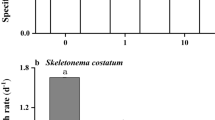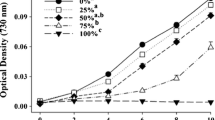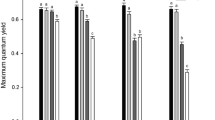Abstract
Cells of the diatomCyclotella meneghiniana were exposed in a closed system to 0.245 ppm 1,2,4-trichlorobenzene. Response to this chlorinated benzene was monitored over a period of 5 days by quantitative ultrastructure and fatty acid percent composition. Over the time period examined, 41 significant morphological changes and 12 significant changes in fatty acid composition were observed. Autophagic-like vacuoles were frequently observed, indicating lysis of cellular constituents. In general, there was an increase in the C20:5 fatty acid, which may be indicative of photosynthetic impairment, since this fatty acid probably substitutes for linolenic acid in diatoms. The most significant numbers of changes were observed after 8 hr of exposure to this lipophilic toxicant, and these changes occurred in membranous organelles. It is suggested that the daily photoperiodic variation in lipid content of phytoplankton may be an important consideration in evaluating effects of lipohilic toxicants.
Similar content being viewed by others
References
Atkinson AW Jr, John PCL, Gunning BES (1978) The growth and division of the single mitochondrion and other organelles during the cell cycle ofChlorella, studied by quantitative stereology and three dimensional reconstruction. Protoplasma 81:77–109
DeMort CL, Lowry R, Tinsley I, Phinney HK (1972) The biochemical analysis of some estuarine phytoplankton species. I. Fatty acid composition. J Phycol 8:211–216
Fogg GE (1956) Photosynthesis and formation of fats in a diatom. Ann Bot 20:265–285
Galassi S, Vighi M (1981) Testing toxicity of volatile substances with algae. Chemosphere 10:1123–1126
Geyer H, Politzki G, Freitag D (1984) Prediction of ecotoxicological behaviour of chemicals; Relationship between n-Octanol/water partition coefficient and bioaccumulation of organic chemical by algaeChlorella. Chemosphere 13:269–284
Geyer H, Scheunert I, Korte F (1985) Relationship between the lipid content of fish and their bioconcentration potential of 1,2,4-trichlorobenzen. Chemosphere 14:545–555
Gibson DT (1976) Initial reactions in the bacterial degradation of aromatic hydrocarbons. Zentralbl Bakteriol Hyg 1 Abt Orig 162:157–168
Goerke H, (1984) Temperature dependent elimination of 2,4,6,2′,4′-pentacholorobinphenyl inNereis virens (Polychaeta). Arch Environ Contam Toxicol 13:347–355
Goerke H, Eder G, Weber K, Ernst W (1979) Patterns of organo-chlorine residue in animals of different trophic levels from the Weser Estuary. Mar Pollut Bull 10:127–133
Guillard RRL (1975) Culture of phytoplankton for feeding marine invertebrates. In Smith WL, Chaney MH (eds) Culture of Marine Invertebrate Animals. Plenum, New York. pp 39–59
Halfon E, Reggiani MG (1986) On ranking chemicals for environmental hazard. Environ Sci Technol 20:1173–1179
Kates M, Volcani BE (1966) Lipid composition of diatoms. Biochim Biophys Acta 116:264–278
Lu P, Metcalf RL (1975) Environmental fate and biodegradability of benzene derivatives as studied in a model aquatic ecosystem. Environ Health Perspect 10:269–284
Matsuo M (1980) The i/o (inorganic/organic)-characters to correlate bioaccumulation of some chlorobenzens in guppies with their chemical structure. Chemosphere 9:409–413
Metcalfe LD, Schmitz AA (1961) The rapid preparation of fatty acid esters for gas chromatographic analysis. Anal Chem 33:363–364
Millie DF (1986) Nutrient-limitation effects on the biochemical composition ofCyclotella meneghiniana (Bacillariophyta): an experimental and statistical analysis. Can J Bot 64:19–26
Neely WB, Branson DR, Blau GE (1974) Partition coefficient to measure bioconcentration potential of organic chemicals in fish. Environ Sci Technol 8:1113–1115
Puiseux-Dao S (1981) Cell-cycle events in unicellular algae. Can Bull Fish Aquat Sci 210:130–149
Schwarzenbach RP, Fisher NS (1978) Rapid determination of the molecular weight distribution of total cellular fatty acids using chemical ionization mass spectrometry. J Lipid Res 19:12–17
Shifrin NS, Chisholm SW (1981) Phytoplankton lipids: interspecific differences and effects of nitrate, silicate, and light-dark cycles. J Phycol 17:374–384
Sicko-Goad L, Lazinsky D (1986) Quantitative ultrastructural changes associated with lead-coupled luxury phosphate uptake and polyphosphate utilization. Arch Environ Contam Toxicol 15:617–627
Sicko-Goad L, Stoermer EF (1979) A morphometric study of lead and copper effects onDiatoma tenue v.elongatum (Bacillariophyta). J Phycol 15:316–321
Sicko-Goad L, Ladewski BG, Lazinsky D (1986) Synertistic effects of nutrients and lead on the quantitative ultrastructure ofCyclotella (Bacillariophyceae). Arch Environ Ciontam Toxicol 15:291–300
Sicko-Goad L, Simmons MS, Lazinsky D, Hall J (1988) Effect of light cycle on diatom fatty acid composition and quantitative morphology. J Phycol 24:1–7
Sicko-Goad L, Stoermer EF, Ladewski BG (1977) A morphometric method for correcting phytoplankton cell volume estimates. Protoplasma 93:147–163
Sicko-Goad L, Stoermer EF Schelske CL (1984) Estimation of intracellular carbon and silica content of diatoms from natural assemblages using morphometric techniques. Limnol Oceanogr 29:1170–1178
Smith RE, Geider RJ (1985) Kinetics of intracellular carbon allocation in a marine diatom. J Exp Mar Biol Ecol 93:191–210
Varum KM, Myklestad S (1984) Effects of ligth, salinity and nutrient limitation on the production of B-1, 3-D-Glucan and Exo-D-Glucanase activity inSkeletonema costatum (Grev.) Cleve. J Exp Mar Biol Ecol 83:13–25
Wada M, Hara Y, Kato M, Yamada M, Fujii T (1987) Diurnal appearance, fine structure, and chemical composition of fatty particles inHeterosigma okashiwo (Raphidophyceae). Protoplasma 137:134–139
Watson ML (1958) Staining tissue sections for electron microscopy with heavy metals. J Biophys Biochem Cytol 4:475–478
Williams RT, Hiron PC, Renwick AG (1975) Species variation in the metabolism of some organic halogen compounds. In Ecological Toxicology Research, Effects of Heavy Metal and Organohalogen Compounds. Plenum Press, New York, pp 91–106
Author information
Authors and Affiliations
Rights and permissions
About this article
Cite this article
Sicko-Goad, L., Lazinsky, D., Hall, J. et al. Effects of chlorinated benzenes on diatom fatty acid composition and quantitative morphology. I. 1,2,4-Trichlorobenzene. Arch. Environ. Contam. Toxicol. 18, 629–637 (1989). https://doi.org/10.1007/BF01225001
Received:
Issue Date:
DOI: https://doi.org/10.1007/BF01225001




